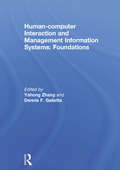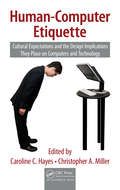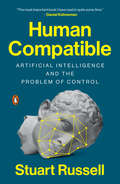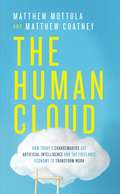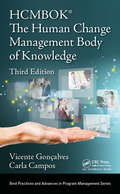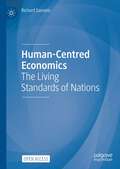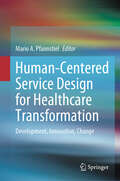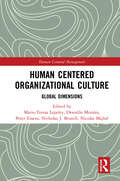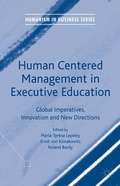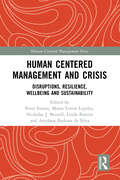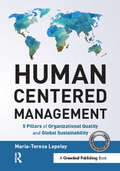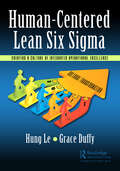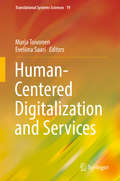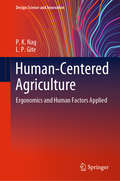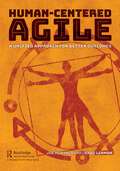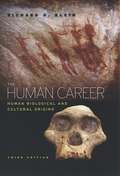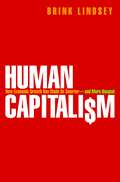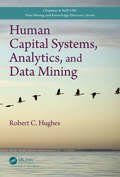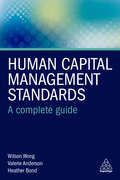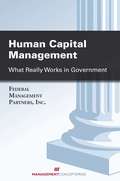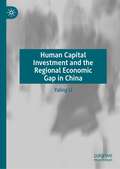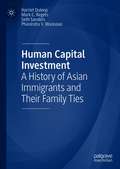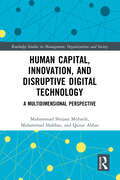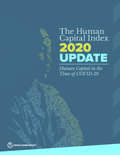- Table View
- List View
Human-computer Interaction and Management Information Systems: Foundations (Advances In Management Information Systems Ser.)
by Ping Zhang Dennis F. Galletta"Human-Computer Interaction and Management Information Systems: Foundations" offers state-of-the-art research by a distinguished set of authors who span the MIS and HCI fields. The original chapters provide authoritative commentaries and in-depth descriptions of research programs that will guide 21st century scholars, graduate students, and industry professionals. Human-Computer Interaction (or Human Factors) in MIS is concerned with the ways humans interact with information, technologies, and tasks, especially in business, managerial, organizational, and cultural contexts. It is distinctive in many ways when compared with HCI studies in other disciplines. The MIS perspective affords special importance to managerial and organizational contexts by focusing on analysis of tasks and outcomes at a level that considers organizational effectiveness. With the recent advancement of technologies and development of many sophisticated applications, human-centeredness in MIS has become more critical than ever before. This book focuses on the basics of HCI, with emphasis on concepts, issues, theories, and models that are related to understanding human tasks, and the interactions among humans, tasks, information, and technologies in organizational contexts in general.
Human-Computer Etiquette: Cultural Expectations and the Design Implications They Place on Computers and Technology (Supply Chain Integration Modeling, Optimization and Application)
by Caroline C. Hayes Christopher A. MillerWritten by experts from various fields, this edited collection explores a wide range of issues pertaining to how computers evoke human social expectations. The book illustrates how socially acceptable conventions can strongly impact the effectiveness of human-computer interactions and how to consider such norms in the design of human-computer inter
Human Compatible: Artificial Intelligence and the Problem of Control
by Stuart Russell"The most important book I have read in quite some time" (Daniel Kahneman); "A must-read" (Max Tegmark); "The book we've all been waiting for" (Sam Harris)A leading artificial intelligence researcher lays out a new approach to AI that will enable us to coexist successfully with increasingly intelligent machinesLonglisted for the 2019 Financial Times/McKinsey Business Book of the Year AwardIn the popular imagination, superhuman artificial intelligence is an approaching tidal wave that threatens not just jobs and human relationships, but civilization itself. Conflict between humans and machines is seen as inevitable and its outcome all too predictable. In this groundbreaking book, distinguished AI researcher Stuart Russell argues that this scenario can be avoided, but only if we rethink AI from the ground up. Russell begins by exploring the idea of intelligence in humans and in machines. He describes the near-term benefits we can expect, from intelligent personal assistants to vastly accelerated scientific research, and outlines the AI breakthroughs that still have to happen before we reach superhuman AI. He also spells out the ways humans are already finding to misuse AI, from lethal autonomous weapons to viral sabotage. If the predicted breakthroughs occur and superhuman AI emerges, we will have created entities far more powerful than ourselves. How can we ensure they never, ever, have power over us? Russell suggests that we can rebuild AI on a new foundation, according to which machines are designed to be inherently uncertain about the human preferences they are required to satisfy. Such machines would be humble, altruistic, and committed to pursue our objectives, not theirs. This new foundation would allow us to create machines that are provably deferential and provably beneficial.In a 2014 editorial co-authored with Stephen Hawking, Russell wrote, "Success in creating AI would be the biggest event in human history. Unfortunately, it might also be the last." Solving the problem of control over AI is not just possible; it is the key that unlocks a future of unlimited promise.
The Human Cloud: How Today's Changemakers Use Artificial Intelligence and the Freelance Economy to Transform Work
by Matthew Mottola Matthew Douglas CoatneyWith the technical world of work changing rapidly, don't leave anything to chance. In The Human Cloud, two workforce productivity and technology experts lay out a clear picture of the coming revolution in how work is done and how jobs are shaped, empowering you with practical advice to take charge of your future.If you listen to the news, robots are coming for your job. Full-time employment will soon be a thing of the past as organizations opt more and more to hire employees on a contract basis. And thanks to technological advances across email, video, project management, and instant messaging platforms, being tied to a desk working full time for one company is becoming obsolete.These predictions have many of us asking, "Where does that leave me?&”The Human Cloud just may be the most important book you read to prepare for the future of the way work is done. In these pages, a human cloud technologist and an AI expert help you not only clearly understand the transition you see happening around you, but they will also help you take advantage of it.By replacing fear with knowledge, you will better understand how this shift in employment is a good thing, be equipped to embrace the positive advantages new technology brings and use it all to your benefit, and further secure how your own job is shaped so you are never left behind.Topics unpacked in The Human Cloud include:How employees and employers will be able to take advantage of the new automated and freelance-based workplace.How they will be able to take advantage of the new technology disruptions the machine cloud will create.Why the changes employees and employers are seeing aren&’t the projection of doom that many are predicting; they can actually create many new career opportunities.How to navigate the coming job marketplace.
The Human Change Management Body of Knowledge (Best Practices in Portfolio, Program, and Project Management)
by Vicente Goncalves Carla Campos"I am happy to recommend this work. I believe in the principles presented in it and identify with its context. Due to the lack of knowledge on the subject in the market, it is a topic that must be made known. The book should be in the library of all project and change managers."— Paul Dinsmore, PMI Fellow "Every manager should integrate HCMBOK® practices into their project management methodology in order to fully develop their work. This book addresses a simple and practical way that the critical component in organizational change management can be applied to projects of all kinds: the human factor."— Bruno Machado, Director, Project Management Office, Grupo Anima Educação "We live in a time of change, speed, and an avalanche of information. It is still very difficult for most companies to change their organizational culture efficiently. This book makes us reflect upon the crucial element in any change, and which most managers do not place in the foreground—the people." — Joyce Meyer, CEO, iDigo "In today's constantly changing world, the Project Manager must have sensitivity to how people react to change. Knowing a method that provides a structured way to take care of the human aspect is a key factor in the success of any project! HCMBOK® offers a simple and practical approach to managing change, which can be easily incorporated into the project management routine, providing amazing results."— Pedro Augusto Cardoso da Silva, Engineering Director, METRÔRIO This reference starts by presenting the concept of change management, its players, strategies, and applicable models. In the second part, the book covers the set of good practices, methodology, and tools known as the HCMBOK®— Human Change Management Body of Knowledge. The third part introduces the concept of the Change Management Office (CMO) and its relation to the strategic planning of an organization. The book concludes with the competencies essential for a change manager, an approach to agile methodologies, and a model for managing cultural change.
Human-Centred Economics: The Living Standards of Nations
by Richard SamansThis open access book examines the chronic underperformance of economies with respect to inclusion, sustainability and resilience. It finds that the standard liberal economic growth and development model has evolved over the past century in a fundamentally unbalanced manner that underemphasizes the crucial role of institutions – legal norms, policy incentives and public administrative capacities – in translating market-based growth in the production of goods and services into broad and sustainable gains in social welfare at the household level. Correcting this imbalance of emphasis in economic theory and policy between markets and institutions, production and distribution, and national income and household living standards is the single most important step required to transcend 20th century trickle-down “neoliberalism” and replace it with a more human-centred model of economic progress in the 21st century. The book breaks new ground by integrating the principal institutional dimensions of the social contract into the heart of macroeconomic theory and presenting extensive corresponding reforms of domestic and international economic policy to refocus them on the median living standards, rather than primarily aggregate wealth or GDP, of nations. This is the bottom-line measure of national economic performance, and it depends on the strength of both markets of exchange and institutions in such areas as labour and social protection, financial and corporate governance, competition and rents, anti-corruption, infrastructure and basic necessities, environmental protection, education and skilling, etc. Extensive comparative data are presented demonstrating that countries at every level of economic development have ample policy space to narrow their “welfare gaps” – their underperformance on these and other key aspects of household living standards relative to the frontier of leading policy practice in peer countries.
Human-Centered Service Design for Healthcare Transformation: Development, Innovation, Change
by Mario A. PfannstielThis book explores the use of human-centered service design. Through a variety of case studies and best practices, it highlights ways to systematically improve the provision of healthcare services to different target and age groups in order to understand customer expectations and needs. The book also offers new insights into the dyadic relationship between service provider and customer, each of which has their own set of goals, purposes, and benefits and must cope with a scarcity of resources and opportunities to optimize and design. Written by recognized experts, scholars, and practitioners, this book demonstrates how, where, and when to successfully apply human-centered service design at multiple levels, including corporate, departmental, and product/service. Value-added services are not only assessed in terms of their effectiveness, efficiency, and productivity, but also bearing in mind human emotions, interactions, and communication techniques as an important part of service provision. Accordingly, the book will appeal to scholars and practitioners in the hospital and healthcare sector, and to anyone interested in organizational development, service business model innovation, customer involvement and perceptions, and the service experience.
Human Centered Organizational Culture: Global Dimensions (Human Centered Management)
by Maria-Teresa LepeleyThis book is part of the Human Centered Book Trilogy, the 2021 volumes of the Routledge Human Centered Management HCM Series. HCM books are pioneering transformation from the traditional humans-as-a-resource approach of the industrial past, to the humans at the center management and organizational paradigm of the 21st century. HCM is built on talent and wellbeing of people in the workplace driving work engagement, quality standards, high performance and productivity for long-term organizational sustainability in the global VUCA (volatile, uncertain, complex, ambiguous) environment. This book was carefully crafted by recognized international human centered scholars from four continents. Although all organizations seek to have an optimal culture, unstoppable disruptions in the VUCA environment easily derail even the best efforts. Conventional assumptions of culture as a unifying organizational force are hardly defendable today. HCM maintains that culture is not only about cohesiveness and consensus but effective management of conflict and disagreements continuously testing the capacity of people to work together. This book is about organizational transformation positioning people at the center. Complementary chapters integrate as antidotes to overcome disruptions in the VUCA environment and the effects of the COVID-19 pandemic affecting people and organizations worldwide. This and its two complementary titles Soft Skills for Human Centered Management and Global Sustainability and Sensible Leadership: Human Centered, Insightful and Prudent are timely readings for leaders, managers, researchers, academics, practitioners, students and the general public responsible for organizations across industries and sectors worldwide pursuing quality standards and organizational transformation to attain sustainability.
Human Centered Management in Executive Education: Global Imperatives, Innovation and New Directions (Humanism in Business Series)
by Maria-Teresa Lepeley Roland Bardy Ernst KimakowitzHuman Centered Management in Executive Education provides a comprehensive insight on innovation in Executive Education with a unique global scope. The book integrates studies and experiences of 32 distinguished scholars from 15 countries who are working in the development of theories and practices to advance the human centered management paradigm, sustainability-based quality standards and continuous improvement in education. The discussion presents a well-balanced outlook that combines and contrasts research and programs from 16 developed and 16 developing countries, and the visions of 10 female and 22 male authors from North America, South America, Europe, Asia, the Middle East and Africa.
Human Centered Management and Crisis: Disruptions, Resilience, Wellbeing and Sustainability (Human Centered Management)
by Peter Essens Maria-Teresa Lepeley Nicholas J. Beutell Linda Ronnie da Silva, Anielson BarbosaHuman Centered Management and Crisis: Disruptions, Resilience, Wellbeing and Sustainability is the new edited book of the Human Centered Management (HCM) Series developed to respond to surmounting concerns of global audiences and human centered scholars, practitioners and students searching for answers to better and objectively understand the effects of unprecedented Covid-19 pandemic disruptions and ongoing crises, affecting the wellbeing of people and workplaces since 2019. The effects linger and solutions are pressing. This new HCM volume presents analytical expertise and practical experiences of a team of international HCM scholars and practitioners targeting objective assessment of causes and effects of disruptions and offering coherent solutions applying HCM principles and practices. The book chapters include topics dealing with specific problem-solving strategies in numerous industries, among them, higher education, health care and entrepreneurship. The book will help readers worldwide to understand the challenges people and organizations are facing in the present global VUCA (volatile, uncertain, complex, ambiguous) environment. The audience will benefit from the book and its purpose to deliver enduring HCM solutions anchored in the wellbeing of people as precondition for organizations to secure high performance, quality standards and long-term sustainability.
Human Centered Management: 5 Pillars of Organizational Quality and Global Sustainability (Human Centered Management)
by Maria-Teresa LepeleyWe have never had more freedom to acquire information to make decisions, and organizations have never been so pressed to demonstrate accountability as they communicate with better informed customers and users. People who work IN an organization must also work FOR the organization to accomplish its mission. In this environment, humans are no longer just a resource; they are the reason an organization exists. New constructs are needed to ensure this human-centered paradigm shift.This book sets out the rationale for this shift and stimulates the discussion and the discovery of effective approaches and solutions to innovate for social and environmental good. Written by an expert in quality standards, the book offers a coherent model which synchronizes the organizational structure with the talent required to develop resilient and agile work environments. New strategies to develop talent will be critical, and multidisciplinary approaches from scholars and practitioners from around the world will be required to effectively collaborate and articulate the solutions. The proposition in the book focuses on continuous improvement and interdisciplinary collaboration between scholars and practitioners across different industries, sectors, and national borders in order to address the unavoidable disruptions in the global VUCA environment.
Human-Centered Lean Six Sigma: Creating a Culture of Integrated Operational Excellence
by Hung Le Grace DuffyThis book focuses on the human side of organizational culture. The authors approach organizational culture from the perspective of alignment to mission, vision, and values. Using a Lean Six Sigma structure, the sequence of chapters begins with the organization and its structure, then drills through strategic, operational, and tactical levels of process and behavior which establish and grow the overall culture of the organization over time. The book begins with foundational principles of organization, through the necessity of aligning processes and systems to mission and vision, assessment, gap analysis for improvement, prioritization, and chapters on qualitative and quantitative approaches for reducing variation and improving systems and behavior. Through this book, readers will: Learn the foundation and core concepts of the organization Discover the "right" focus of shifting the culture of the organization Recognize the building blocks of organizational culture and how to integrate them into a successful, customer-focused system of interconnected processes Focus on people as drivers of technology, rather than the reverse Explore techniques to address the challenges and concerns of today’s training and deployment for organizational performance excellence Use the chapters as short discussions or training workshops for either internal education or public/private technical education.
Human-Centered Digitalization and Services (Translational Systems Sciences #19)
by Marja Toivonen Eveliina SaariThis book provides a timely overview of the impacts of digitalization from the perspective of everyday life, and argues that one central issue in digitalization is the development of new types of services that digitalization enables, but which are often overlooked due to the focus on new technologies and devices. The book summarizes the past 20 years of research into the relationship between information and communications technology (ICT) and service innovation, and reveals that the ongoing digitalization is a qualitatively different phenomenon and represents a true paradigm shift.The all-encompassing integration and distribution of data raises critical issues such as preserving human dignity and individual autonomy; moreover, interaction practices that foster broad participation, trust, learning, and a willingness to share knowledge are called for. Citizen empowerment and multi-actor co-creation have become central to using digitalization to support the development of wellbeing and sustainability.Further, the book shows how employees and professionals can and should be involved in designing their future work, and in evaluating it. Proactiveness and participation in innovation endeavours are ways to guarantee meaningful work in an age of socio-technical transition.The book employs a variety of theoretical approaches and perspectives from diverse disciplines to illustrate these needs. In addition to theoretical analyses, some specific application areas are examined, e.g. services in health and social care, and problems linked to robots in elderly care. Given its scope, the book is highly recommended to all readers seeking an overview of the current understanding of the human side of digitalization and searching for concrete cases from different countries to illustrate the topic.
Human-Centered Agriculture: Ergonomics and Human Factors Applied (Design Science and Innovation)
by P. K. Nag L. P. GiteThis book explores the interplay of farm mechanization, human factors and climatic and other environmental uncertainty in agriculture, using an ergonomics based approach to discuss solutions to the traditionally acknowledged vulnerability of the sector. It converges contemporary research documentation, case studies and international standards on agricultural ergonomics, engineering anthropometry, human factors, basic occupational health services, safety management, human performance and system sustainability to provide a handy reference to students and professionals working to optimize agricultural output while balancing the rational utilization of labour in agricultural practices and human well-being.
Human-Centered Agile: A Unified Approach for Better Outcomes
by Joe Montalbano Brad LehmanThis book is a guide on how to apply Human-Centered Design (HCD) practices to an Agile product development model that is used widely throughout industry and government, where it is applied primarily to software and technology development efforts. This has been an ongoing industry challenge due to the fact that HCD prioritizes time spent understanding the problems to be solved (time spent in the problem space), while Agile prioritizes a fast hypothesize-and-deliver model (time spent in the solution space). Organizations that attempt an Agile transformation abandon it either because it was too difficult or because it did not deliver the hoped-for results. At the same time, efforts to improve the design and experience of their products using Human-Centered Design have a tendency to fall short because it can be difficult to see the ROI of design efforts, even while companies like McKinsey document design-driven successes. What’s more, a company that successfully adopts Agile often seems to have an even harder time implementing HCD and vice versa. This is particularly disappointing since Agile and HCD should be mutually supportive. In practice, Agile teams often bypass HCD efforts in favor of finishing their goals and thinking they are doing well, only to have their work product fail to meet the actual end user’s needs. At first the team will become indignant. “We followed the expert guidance of our Product Owner, the ‘Voice of the Customer,’” they will say, followed by “but… it met all of the Acceptance Criteria, they should love it.” It’s a failure of Agile that this type of sub-optimal delivery happens so regularly and predictably. The fact that team responses can be so accurately predicted in advance (by those who’ve seen this movie many times before) point to a process failure or inefficiency that is widespread and desperately needs to be addressed. Alternatively, teams will invest too heavily in up-front discovery efforts that slow down delivery to an unacceptable point, often while also failing to capture research-based findings in a way that matures the overall strategic product or portfolio understanding. The cost of misfiring goes far beyond a bad delivery or an angry customer. Decreased team morale drives poorer future performance (cost), turnover if left unchecked (more cost), and non-productive blame sessions that lead to degraded faith in the Agile product development model itself. This book identifies solutions based on successful methods of integrating HCD practices by phase into an ongoing agile delivery model, from the discovery through implementation and evaluation, including: key success factors for an HCD/Agile engagement approach, critical points of delivery, and strategies for integrating HCD into teams based on the existing design maturity of an organization or product team.
The Human Career: Human Biological and Cultural Origins (3rd edition)
by Richard G. KleinKlein (anthro, U. of Chicago) summarizes our current knowledge and ongoing debates about human evolution from the earliest primates to modern man. Both the fossil and archaeological evidence is examined, showing the relationship between human form and behavior.
Human Capitalism: How Economic Growth Has Made Us Smarter--and More Unequal
by Brink LindseyWhy the rich are getting smarter while the poor are being left behindWhat explains the growing class divide between the well educated and everybody else? Noted author Brink Lindsey, a senior scholar at the Kauffman Foundation, argues that it's because economic expansion is creating an increasingly complex world in which only a minority with the right knowledge and skills—the right "human capital"—reap the majority of the economic rewards. The complexity of today's economy is not only making these lucky elites richer—it is also making them smarter. As the economy makes ever-greater demands on their minds, the successful are making ever-greater investments in education and other ways of increasing their human capital, expanding their cognitive skills and leading them to still higher levels of success. But unfortunately, even as the rich are securely riding this virtuous cycle, the poor are trapped in a vicious one, as a lack of human capital leads to family breakdown, unemployment, dysfunction, and further erosion of knowledge and skills. In this brief, clear, and forthright eBook original, Lindsey shows how economic growth is creating unprecedented levels of human capital—and suggests how the huge benefits of this development can be spread beyond those who are already enjoying its rewards.
Human Capital Systems, Analytics, and Data Mining (Chapman & Hall/CRC Data Mining and Knowledge Discovery Series)
by Robert C. HughesHuman Capital Systems, Analytics, and Data Mining provides human capital professionals, researchers, and students with a comprehensive and portable guide to human capital systems, analytics and data mining. The main purpose of this book is to provide a rich tool set of methods and tutorials for Human Capital Management Systems (HCMS) database modeling, analytics, interactive dashboards, and data mining that is independent of any human capital software vendor offerings and is equally usable and portable among both commercial and internally developed HCMS. The book begins with an overview of HCMS, including coverage of human resource systems history and current HCMS Computing Environments. It next explores relational and dimensional database management concepts and principles. HCMS Instructional databases developed by the Author for use in Graduate Level HCMS and Compensation Courses are used for database modeling and dashboard design exercises. Exciting knowledge discovery and research Tutorials and Exercises using Online Analytical Processing (OLAP) and data mining tools through replication of actual original pay equity research by the author are included. New findings concerning Gender Based Pay Equity Research through the lens Comparable Worth and Occupational Mobility are covered extensively in Human Capital Metrics, Analytics and Data Mining Chapters.
Human Capital Readiness
by Robert S. Kaplan David P. NortonHow do organizations develop a measure of human capital (HC) readiness? This measure represents the availability of employee skills, talent, and know-how to perform the internal processes critical to the strategy's success. This chapter introduces a framework that enables organizations to identify HC requirements for the strategy, estimate the gap between the HC requirements and current employee readiness, and build programs to close that gap.
Human Capital Management Standards: A Complete Guide
by Dr Wilson Wong Valerie Anderson Heather BondHuman Capital Management Standards is a complete guide to the BSI and ISO frameworks for human resources. Providing definitions, best practice guidance and evaluation metrics, this book will ensure that HR professionals are fully compliant with both UK and global HR frameworks. Covering everything from workforce planning and organizational culture to employee engagement, recruitment and redundancy, this book provides advice on all the key areas of an HR professional's role throughout the employee lifecycle from initial hire to exit. There is also additional coverage of the business standards which overlap with the human capital frameworks including governance, business continuity and ethics. Human Capital Management Standards will allow HR departments to implement effective people policies and processes based on robust research to create a supportive business environment and a productive workforce. This book also includes essential coverage of the standards assessment process and hints, tips and advice on how to achieve successful accreditation. With case studies from organizations who have made HR interventions based on these standards and a glossary to explain the language of standards, this is an indispensable guide for HR professionals in all organizations.
Human Capital Management: What Really Works in Government
by Federal Management Partners, Inc.Many federal agencies have made huge strides to develop, fully utilize, and enhance the effectiveness of their most valuable resource: their workforce. This book captures those successes and relates the stories behind them. Innovative recruitment and retention strategies, dynamic employee onboarding programs, leading-edge HR technology—these are some of the stories that offer valuable lessons for anyone dealing with human resources issues in government, business, or any other organizational environment. The authors highlight not only the successful outcomes of various agency programs, but also consider the bumps and hurdles encountered and overcome along the way. Rather than a theoretical presentation of what might, or should, work, Human Capital Management: What Really Works in Government provides thought-provoking and practical examples detailing what federal agencies are doing that is working.
Human Capital Investment and the Regional Economic Gap in China
by Yaling LiAccording to the neoclassical growth theory and the endogenous growth theory, changes in the stock of capital and labor affect economic growth rates in the short run, and differences in human capital stocks are likely to affect total factor productivity directly and long-term economic growth rates indirectly. Therefore, human capital is a factor in the secular trends of regional economic gaps. In this study, the author examines the relationship between regional economic disparities and the country’s human capital stocks and structure in China between 1990 and 2015, a period of economic transformation in the country. Available empirical evidence supports the argument that boosting investment toward and optimizing the spatial distribution of human capital can help mitigate regional economic disparity and facilitate balanced and coordinated economic development across the country.
Human Capital Investment: A History of Asian Immigrants and Their Family Ties
by Harriet Duleep Mark C. Regets Seth Sanders Phanindra V. WunnavaIn 1965, a family-reunification policy for admitting immigrants to the United States replaced a system that chose immigrants based on their national origin. With this change, a 40-year hiatus in Asian immigration ended. Today, over three-quarters of US immigrants originate from Asia and Latin America. Two issues that dominate discussions of US immigration policy are the progress of post-reform immigrants and their contributions to the US economy. This book focuses on the earnings and human capital investment of Asian immigrants to the US after 1965. In addition, it provides a primer on studying immigrant economic assimilation, by explaining economists’ methodology to measure immigrant earnings growth and the challenges with this approach. The book also illustrates strategies to more fully use census data such as how to measure family income and how to use “panel data” that is embedded in the census. The book is a historical study as well as an extremely timely work from a policy angle. The passage of the 1965 Immigration and Nationality Act set the United States apart among economically developed countries due to the weight given to family unification. Based on analyses by economists—which suggest that the quality of immigrants to the US fell after the 1965 law—policymakers have called for fundamental changes in the US system to align it with the immigration systems of other countries. This book offers an alternative view point by proposing a richer model that incorporates investments in human capital by immigrants and their families. It challenges the conventional model in three ways: First, it views the decline in immigrants’ entry earnings after 1965 as due to investment in human capital, not to permanently lower “quality.” Second, it adds human capital investment and earnings growth after entry to the model. And finally, by taking investments by family members into account, it challenges the policy recommendation that immigrants should be selected for their occupational qualifications rather than family connections.
Human Capital, Innovation and Disruptive Digital Technology: A Multidimensional Perspective (Routledge Studies in Management, Organizations and Society)
by Muhammad Shujaat Mubarik Muhammad Shahbaz Qaisar AbbasHuman capital appears to be at the core of business strategies helping firms to recover from the catastrophic effects of COVID19 and bounce back effectively. The book in hand provides a diverse view of the human capital, its multifaceted role and application in an organization. The book also offers a comprehensive analysis on the role of human capital in industry 4.0, firm internationalization, and organizational ambidexterity and outlines strategies for the firm to improve its human capital readiness, keeping in view the contemporary business dynamics. A very simple and focused approach has been adopted through the book to make it readable for the people from the diverse fields. The book also focuses upon the conceptualizations and measurements of human capital in order to offer conceptual clarity of human capital to readers. A central focus of the book is how human capital interacts with and complements other organizational resources and technological developments. The book will be extremely useful for top-tier managers, researchers, academicians, consultants, and practitioners interested in gaining a current, relevant, and diverse perspective on human capital, its dimensions, and development.
The Human Capital Index 2020 Update: Human Capital in the Time of COVID-19
by World BankHuman capital—the knowledge, skills, and health that people accumulate over their lives—is a central driver of sustainable growth, poverty reduction, and successful societies. More human capital is associated with higher earnings for people, higher income for countries, and stronger cohesion in societies. Much of the hard-won human capital gains in many economies over the past decade is at risk of being eroded by the COVID-19 (coronavirus) pandemic. Urgent action is needed to protect these advances, particularly among the poor and vulnerable. Designing the needed interventions, targeting them to achieve the highest effectiveness, and navigating difficult trade-offs make investing in better measurement of human capital now more important than ever. The Human Capital Index (HCI)—launched in 2018 as part of the Human Capital Project—is an international metric that benchmarks the key components of human capital across economies. The HCI is a global effort to accelerate progress toward a world where all children can achieve their full potential. Measuring the human capital that children born today can expect to attain by their 18th birthdays, the HCI highlights how current health and education outcomes shape the productivity of the next generation of workers and underscores the importance of government and societal investments in human capital. The Human Capital Index 2020 Update: Human Capital in the Time of COVID-19 presents the first update of the HCI, using health and education data available as of March 2020. It documents new evidence on trends, examples of successes, and analytical work on the utilization of human capital. The new data—collected before the global onset of COVID-19—can act as a baseline to track its effects on health and education outcomes. The report highlights how better measurement is essential for policy makers to design effective interventions and target support. In the immediate term, investments in better measurement and data use will guide pandemic containment strategies and support for those who are most affected. In the medium term, better curation and use of administrative, survey, and identification data can guide policy choices in an environment of limited fiscal space and competing priorities. In the longer term, the hope is that economies will be able to do more than simply recover lost ground. Ambitious, evidence-driven policy measures in health, education, and social protection can pave the way for today’s children to surpass the human capital achievements and quality of life of the generations that preceded them.
